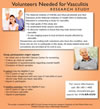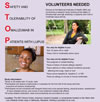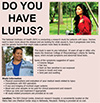FEATURE STORY
Letter from Dr. Stephen I. Katz: NIAMS Continues Efforts to Reach Multicultural Communities
Dear Colleagues:
The National Institutes of Health (NIH) and the NIAMS have a long-standing commitment to ensure that everyone living in the United States has the same opportunity to live healthy and productive lives. One important way we achieve this goal is to make our health information culturally and linguistically appropriate for diverse populations. It is in this vein that the NIH has recently developed its Language Access Plan, which establishes the steps NIH will take to help ensure that people with limited English proficiency have meaningful access to NIH programs, activities and resources.
NEWS AND EVENTS

Siblings Help Advance CANDLE Syndrome Research
T.J. spent the first year of his life in and out of the hospital, being treated with antibiotics and steroids for vasculitis, a condition that occurs when the immune system attacks the blood vessels by mistake, causing inflammation, pain and damage to the internal organs. When he was only 18 months old, doctors told his parents they had exhausted all the treatment options that were available.
Told that this genetic disorder only occurred in males, a little over a year later, T.J.’s mother gave birth to a daughter, Tashana Rae, who had the same rare genetic mutation called CANDLE syndrome. The family was referred to Dr. Raphaela Goldbach-Mansky at the NIAMS.
Chronic Low-Back Pain Research Standards Announced by NIH Task Force
Recommended standards for clinical low-back pain research hold promise for more consistently designed research and, in the long term, better treatment solutions to support those living with chronic low-back pain. The recommendations from the NIH Task Force on Research Standards for Chronic Low-Back Pain, which were supported in part by the NIAMS, were published in several leading back pain journals.
NIH Research Featured In National Geographic Channel Documentary on Sleep
The National Institutes of Health (NIH), in partnership with the National Geographic Channel and The Public Good Projects, will draw the nation’s attention to the health consequences of sleep deprivation and what keeps Americans up at night. The documentary, “Sleepless in America,” premiered on the National Geographic Channel on November 30. For more information about “Sleepless in America” showtimes and online availability, visit this NIH webpage. The NIAMS has also invested in sleep research. In 2013, the NIAMS reported on a study about pain processing and sleep disturbance. Also in 2013, the NIAMS sponsored a retreat to explore the importance of circadian regulation in NIAMS’ mission areas.
Stress and Relaxation Techniques
Relaxation techniques may be helpful in managing a variety of health conditions, including anxiety associated with illnesses or medical procedures, insomnia, labor pain, chemotherapy-induced nausea and temporomandibular joint dysfunction. For some of these conditions, relaxation techniques are used as an adjunct to other forms of treatment. Relaxation techniques have also been studied for other conditions, but either they haven’t been shown to be useful, research results have been inconsistent or the evidence is limited. This resource features a section on fibromyalgia.
Events
Behavioral and Social Sciences Lectures
The NIH Behavioral and Social Sciences Research Coordinating Committee and the Office of Behavioral and Social Sciences Research regularly convene a series of guest lectures and symposia on selected topics in the behavioral and social sciences. These presentations by prominent behavioral and social scientists provide overviews of current research on topics of scientific and social interest. All seminars are open to the public.
NIH Health Disparities Seminar Series
The National Institute on Minority Health and Health Disparities (NIMHD) sponsors the monthly NIH Health Disparities Seminar Series. The forum disseminates information on advances, gaps and current issues related to health disparities research. It features national and international health disparities research experts, including many funded by the NIMHD, the other NIH Institutes and Centers and federal agency partners. Each seminar focuses on a specific theme.
FEATURED RESOURCES
February Is African American History Month
African Americans have a rich heritage rooted in a deep sense of family, community and resilience. It’s also important to know that being African American may mean having an increased risk for certain health conditions, like osteoarthritis or lupus. To celebrate African American History Month, take some time and learn how to manage these and other conditions. In celebrating family, what can be more important than taking care of one’s health?
Three NIAMS Studies Currently Recruiting at the NIH Clinical Center in Bethesda, Maryland
Studies of the Natural History, Pathogenesis and Outcome of Idiopathic Systemic Vasculitis
Vasculitis is a group of diseases that inflame and damage blood vessels and tissue. Few tests can diagnose the disease, and none can reliably predict a relapse. Researchers want to study people’s genes and follow people over time to see how the disease affects them. In addition, researchers want to learn what causes vasculitis, learn what markers in blood might help doctors treat vasculitis, and use imaging scans to view blood vessels affected by vasculitis.
Safety and Tolerability of Omalizumab in Patients With Lupus
Systemic Lupus Erythematosus (SLE or lupus) is an autoimmune disease that can affect almost any organ. Its symptoms can range in severity from mild to life-threatening and can vary from person to person. Current treatments for lupus are not effective for some people. Omalizumab, a drug that reduces IgE antibodies in the blood, has been used to treat severe asthma. IgE antibodies are also present in some people with lupus, and researchers want to see if omalizumab is a safe and effective treatment for people with lupus.
Study of Systemic Lupus Erythematosus
This protocol will evaluate patients with systemic lupus erythematosus (SLE) and their relatives to learn more about how the disease develops and changes over time. It will also study genetic factors that make a person susceptible to SLE. Patients 10 years of age and older with known or suspected SLE and their relatives may be eligible for this study.
Other Resources
Free Web Content From the National Institute on Aging
The National Institute on Aging (NIA) at the NIH now offers a new, free tool. Use it to get credible, relevant health information for your website. You don’t have to write your own material or worry about updating it. The information—based on the latest scientific findings—will update automatically.
Topics available include:
- Exercise for older people
- Falls
- Osteoporosis
Spanish and English versions are available. Download the guide [Word - 935 KB] to learn how to create a free account and browse NIA health topics. Simply add the code to your site and the information you select shows up in the style of your own website.
Easy-to-Understand Medicine Instructions Available From AHRQ in Six Languages
New standardized instructions that improve patients’ understanding of when to take medications, and possibly reduce errors while improving adherence, are available from the Agency for Healthcare Research and Quality (AHRQ) Pharmacy Health Literacy Center. The instructions for taking pills follow the Universal Medication Schedule, which simplifies complex medicine regimens by using standard time periods (morning, noon, evening and bedtime). They are available in English, Chinese, Korean, Russian, Spanish and Vietnamese. The instructions were developed in response to research that has shown that more explicit prescription medicine instructions are better understood than instructions that are vague or require an individual to calculate when to take a medicine. The AHRQ Pharmacy Health Literacy Center provides pharmacists with tools and other resources, such as the Pharmacy Health Literacy Assessment Tool.
Quick Health Data Online From the HHS Office on Women’s Health
The U.S. Department of Health and Human Services (HHS) Office on Women’s Health has developed Quick Health Data Online, an online database that offers extensive information on a variety of health and health-related topics. The system provides state- and county-level data for all 50 states, the District of Columbia and U.S. territories and possessions. Data are available by gender, race and ethnicity and come from a variety of national and state sources. The website explains the data sources and data analysis methods. The Frequently Asked Questionsprovide additional details on calculation of various indicators, frequency of system updates and more.
Gather and Share Your Family Health History
If you are concerned about a disease running in your family, collect your family health history and talk to your doctor at your next visit. A doctor can evaluate all of the factors, including family health history, which may affect your risk of diseases, and can recommend ways to reduce that risk. Other HHS family health history resources include: the Surgeon General’s Family Health History Initiative, the Centers for Disease Control and Prevention’s (CDC) Office of Public Health Genomics and the National Human Genome Research Institute’s (NHGRI) Family History webpage.
CDC—Antibiotics Aren’t Always the Answer
Antibiotics do not fight infections caused by viruses like colds, flu, most sore throats, bronchitis, and many sinus and ear infections. Instead, symptom relief might be the best treatment option for viral infections. Get smart about when antibiotics are needed—to fight bacterial infections. When you use antibiotics appropriately, you do the best for your health, your family’s health and the health of those around you.
NIH News in Health
Read practical health information in NIH News in Health, which is reviewed by the NIH’s medical experts and is based on research conducted either by the NIH’s own scientists or by its grantees at universities and medical schools around the country.
Osteoporosis in Aging: Protect Your Bones With Exercise
There’s a lot you can do to reduce your risk for osteoporosis, a condition that affects more than 10 million people nationwide. Getting plenty of calcium, vitamin D and exercise is a good start.
NIH MedlinePlus Magazine
NIH MedlinePlus magazine presents reliable, up-to-date health information and the latest breakthroughs from NIH-supported research.
WHERE IS NIAMS?

The NIAMS exhibit will be traveling to several events in 2015. See the schedule of health fairs and exhibits.
The NIAMS can provide health information or staff to help make your community event or health fair successful. Please contact Sara Rosario Wilson by email, [email protected], for more information.
Image: the NIAMS Exhibit










